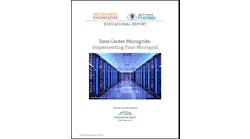May 6, 2013
You know that experience, when you buy a new car, and suddenly you see the model everywhere? Since Superstorm Sandy I’ve had the equivalent experience with the term ‘microgrid.’
Policymakers and thought leaders in the US Northeast started talking microgrid in earnest shortly after the October 2012 storm leveled swaths of their region. Lately, the term seems to arise in almost every interview I do about transmission and reliability – whether about the US, Japan, Sweden, India or other areas of the world.
These small, electricity islands have been around for a long time, but mostly confined to colleges and military bases. Are we about to see more widespread development?
Microgrids are smaller versions of the larger grid, but the power plants are closer to the customer. Hence, they have fewer miles of wire that is vulnerable to falling trees. They are typically connected to the larger grid. But when the grid goes down, the microgrid can disengage and keep operating. So microgrids are used as a way to maintain electric reliability in carved-out areas.
I recently asked three respected smart grid experts for their views on a potential microgrid boom, and they gave me three different slants.
“Truthfully, I think microgrid is a very good concept – it has certain applications – but not in general,” said GE’s John McDonald, director of technical strategy and policy development for GE Energy Management’s Digital Energy.
He sees microgrid as successful in rural areas on military bases and at universities. “But you wouldn’t want to have, in the Continental US, the grid be composed of thousands of little microgrids. It would be very difficult to manage that,” McDonald said.
Bradley Williams, vice president for industry strategy at Oracle Utilities, has a different view. Information technology can solve problems that inhibit more widespread use of microgrid, he says.
“The military bases and campuses are piloting this, but that is just the beginning,” Williams said.
He envisions communities driving future microgrid development, particularly those with building codes that require solar, wind or other forms of self-generation.
“I do think it is coming: it will not be driven by the utilities,” he said, adding that utilities will get on board once they know microgrids pose no danger to line workers – an information management issue that Oracle is working on.
Meanwhile, Michael Gordon, CEO of Joule Assets, describes the coming microgrid as a bundling of distributed generation and virtual power plants, which can serve utility resource needs.
Microgrid will help alleviate a kind of inefficiency beginning to emerge on the grid as more and more consumers and businesses buy their own generators following each big storm, he said.
“People are installing things that are not cost-effective because they don’t want a one week outage,” said Gordon, whose New York company helps create energy reduction assets.
What’s coming are microgrids made up of consumer-producers who will sell into the various electricity markets, Gordon said. The consumer will finance and build the asset and then sell energy, efficiency or demand reduction. The utility may act as buyer.
It is not only Superstorm Sandy that is spurring talk of microgrid. Discussion heightened about the concept, as well, after the 2011 earthquake and tsunami in Japan. The Sendai microgrid at Tohoku Fukushi University continued to provide power while the rest of the grid failed, points out a PWC report, “The Future of Microgrids: Their Promise and Challenges.”
Microgrid also is gaining steam because of the Obama administration’s push for more combined heat and power, which is often included within a microgrid. Obama wants the US to build 40 GW of CHP by 2020.
Here are a couple of microgrid developments to watch in the US.
The Connecticut Department of Energy and Environmental Protection in February announced that it is evaluating 27 microgrid projects for possible funding. The projects were among 36 that sought $15 million in available state grants. Some of the projects are sizable – as large as 10 MW. Governor Dannel Malloy has recommended an additional $30 million for the program over the next two years.
In nearby New York, Governor Andrew Cuomo has created an energy highway blueprint to modernize the state’s electric system, which has resulted in several proposals, some of them microgrid.
Many other examples exist of the growing use of microgrids. Readers, please feel free to use the comment section here to let us know about them.







